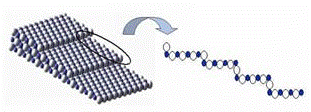Chemistry, Department of: Faculty Series

Marjorie A. Langell Publications
Document Type
Article
Date of this Version
2-18-2008
Abstract
Cobalt oxides comprise two readily accessible cation oxidation states: Co2+ and Co3+, which are thermodynamically competitive under common ambient conditions, and redox mechanisms connecting the two states are largely responsible for their success in partial oxidation catalysis. In our studies, CoO(1 0 0), Co3O4 (1 1 0), and Co3O4 (1 1 1) single crystal substrates have been investigated with X-ray photoelectron spectroscopy (XPS), high-resolution electron energy loss spectroscopy (HREELS), and low energy electron diffraction (LEED) for their surface reactivity toward O2 and H2O and for their stability under reducing UHV conditions. There is facile inter-conversion between CoO and Co3O4 stoichiometry at the oxide surface which, despite the compositional variability, remains well ordered in long-range structure. Surface impurities, however, can pin the surface at either CoO or Co3O4 compositional extremes. Contrary to reports of a pressure gap that creates difficulty in oxide hydroxylation under UHV, it is possible to hydroxylate both cobalt monoxide and spinel oxide substrates with H2O, provided sufficient activation is available to dissociate the water molecule.


Comments
Published in Journal of Molecular Catalysis A: Chemical 281:1–2 (February 18, 2008), pp. 49-58; Selected Papers from the Proceedings of the 4th San Luis Pan-American Conference on the Study of Surfaces, Interfaces and Catalysis; doi 10.1016/j.molcata.2007.08.023 Copyright © 2007 Elsevier B.V. Used by permission. http://www.science-direct.com/science/journal/13811169